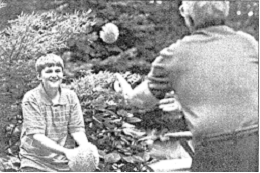Kathleen Fackelmann
USA Today

One step at a time: Ethan takes a homework break with his father, curt Meeder. Research has suggested that autism affects more regions of the brain than prviously thought, and complex or rapic-fire instructions can cause the child to freeze or “tune out.”

A steady pace: Ethan does best when he is not bombarded with too many instructions.
When Ethan Meeder doesn’t follow directions at school, it’s not because he’s stubborn.
The 13-year-old seventh-grader from the Pittsburgh area has a brain that shuts down when he has to process too much at one time. For example, last spring Meeder’s teacher gave him four commands, one right after the other. “He just melted down,” says his mother, Cindy Meeder.
Ethan has an average I.Q., yet he has trouble with things that most people take for granted, such as following directions. “He tests like he should be able to do these things, but he can’t,” Cindy Meeder says.
Ethan has autism, an incurable brain disorder that afflicts about 300,000 school-age children in the USA, according to Los Angeles-based Cure Autism Now.
Studies released in July and August have helped increase scientists’ understanding of how autism affects the brain. The studies fit with other research that suggests that autism is not limited to a few brain regions as once thought, but instead is a global disorder that affects reasoning, memory, balance, multitasking and other skills.
Simple instructions
In the past, scientists believed autism was confined to the brain areas that controlled social interaction, language and behavior. But the new findings indicate that autism affects many parts of the brain and possibly the wiring that connects one brain region to another.
Though some children with autism are mentally retarded, University of Pittsburgh researcher Nancy Minshew and colleagues studied 56 children with autism who had an I.Q. of at least 80, close to the average I.Q. of 100.
The Pittsburgh team gave the children a battery of tests that assessed memory, attention and other skills. The team found that those with autism had no trouble with basic tasks. Many of these children were proficient at spelling and had a good command of grammar, says co-author Diane Williams, also of the University of Pittsburgh.
But the study did find that children with autism faltered when asked to do more complex tasks. While they’re good at details, such children have trouble piecing words together to get the meaning of an entire paragraph or story. They also had difficulty understanding complex figures of speech such as idioms and metaphors. If you tell a child with autism to “hop to it,” he might literally start to hop around the room, Minshew says.
The study, which appears in the August issue of Child Neuropsychology, suggests that children with autism have trouble processing complex information. When a teacher or parent gives a series of rapid-fire commands, the child with autism might get confused and then freeze, Minshew says.
The research suggests kids such as Ethan do better in school with simple instructions given one at a time. “If you give them more detail, they tune it out or they freak out,” Minshew says.
Abnormal wiring?
A second study suggests a biological explanation for the difficulty: A study published online in the journal Cerebral Cortex indicates that the corpus callosum, which connects one part of the brain to another, may be abnormal in autistic people. In this study, people with autism were asked to complete a computer task that requires two parts of the brain to work together.
Brain scans showed that people with autism relied mostly on one brain area to solve the computer puzzle, says Marcel Just, lead author of the study and director of the Center for Cognitive Brain Imaging at Carnegie Mellon University. The findings suggest that people with autism don’t have an efficient way to transfer information from one brain region to another, he says.
The findings add to the emerging picture of autism, but researchers have yet to pinpoint the basic flaws in the brain, says Alice Kau, an autism expert at the National Institute of Child Health and Human Development.
“We still have a lot to learn when it comes to autism,” Kau says.
While everyone waits for the answers that may one day lead to better treatments, Just says parents can take steps now to help their children.
Cindy Meeder is doing just that: With the help of the Pittsburgh research staff, she’s working with Ethan to better negotiate his world.
Every day after school, Cindy Meeder tells Ethan to check his agenda book. She tells him to open his textbook to the right page and then has him go through his homework step by step.
That will help get Ethan through middle school, but Cindy Meeder sometimes wonders about what lies ahead: “We just have to figure out how to get Ethan to do as well as he can.”

